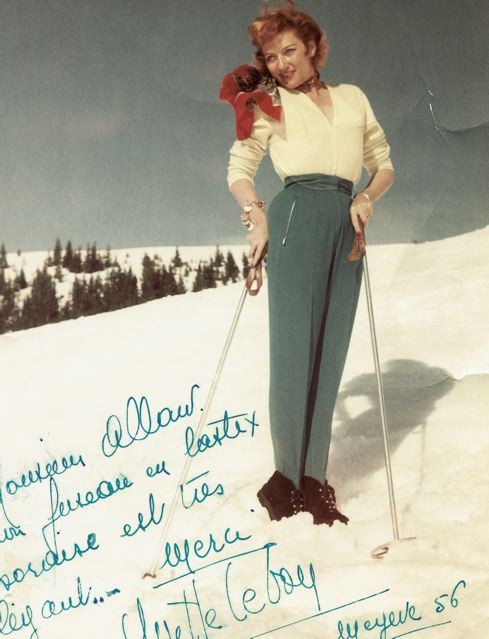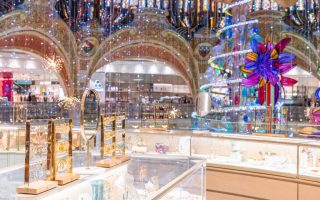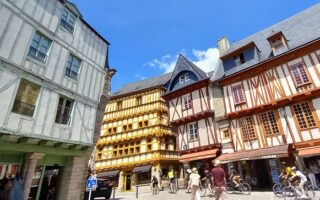AAllard: Family Affair

Few places manage to marry glamour and pure enchantment as beautifully as Megève. Its lovely town center, cut through by a pair of rushing mountain streams, surrounds the Place de l’Eglise, the main square that has been the town’s heart since its pre-resort days, when it was a simple Haute-Savoie farming village. Between the baroque steeple of the church and the sober facade of City Hall stands a five-story building with chalet-style balconies, sculpted wood trim, a towering peaked turret, and unmistakable star quality. A magnet for the crowds that stroll through the square, AAllard is Megève’s most illustrious shop.
The windows showcase skiwear gorgeous enough to tempt the least athletic, and après-ski wear designed to inspire acquisitive lust in even the most sensible shoppers. Inside, counters and racks overflow with cashmere and lamb’s wool sweaters in delectable colors, luxe prêt-à-porter, glove-soft leather jackets and ravishing furs. In a town that boasts Hermès, Dior and a host of other well-known names, AAllard is easily Megève’s most celebrated emporium, and a pure product of its terroir.
AAllard grew up with Megève. Shortly after the town was launched as France’s first ski resort by the Baroness Noémie de Rothschild, the shop was founded in its present location by an entrepreneurial Mégevan named Armand Allard.
Born in Megève in 1904 to a family of farmers, the young Armand was unable to work the land because of a leg crippled by polio. Instead, he apprenticed in the tailor shop of his uncle Antoine, quickly mastering the trade. From the start, he earned a reputation as a perfectionist, demonstrating the good taste and the insistence on quality that would become AAllard hallmarks.
At the age of 22 Armand struck out on his own, opening a tailor shop on the upper floor of an old house on the Place de l’Eglise. The year was 1926, and the Baroness’s luxurious Hôtel du Mont d’Arbois had been attracting amateurs of the relatively new sport of skiing for just two years. Armand’s skills soon brought him customers from beyond the bounds of Megève, and his atelier became a gathering place for clients and friends who came in the evening to watch him work, sometimes into the early hours of the morning, cigarette stuck in the corner of his mouth, tape measure draped around his neck, scissors in hand.
In 1930 a local skier named Hilaire Morand came to the shop with a request. Could Armand design a pair of ski pants better adapted to the sport than the wide, baggy plus fours then being worn? After giving it some thought, Armand designed what he called the pantalon sauteur, long pants that tapered down to the ankle with an elastic strap under the foot. Also known as a fuseau, Armand’s ski pants were destined to make sportswear history. When Morand’s nephew Emile Allais won the World Championship triple crown of skiing in 1937 wearing Allard’s revolutionary new attire, the fame of the fuseau was sewn up throughout the skiing world.
Armand’s business continued to prosper in the 1950s, along with Megève, which became a chic celebrity playground in the post-war party days. Since every fuseau was custom-made and so many clients were Parisians, Armand and his wife Julia made annual trips to the capital in the autumn with suitcases full of fabric. Customers came to their hotel for fittings, Armand measured and Julia took the orders. Back in Megève, Armand and his team (by then up to thirty culottières, or pants-makers) started work; several more fittings in Paris were required, and when the clients arrived in Megève their new fuseaux were waiting.
It didn’t take long for ski pants to acquire an off-piste life of their own, especially when new stretch fabrics were developed. Fashionable French women recognized their flattering, leg-lengthening look, paired them with heels instead of ski boots and started wearing them around town.
Armand began to broaden his collection, introducing some ready-to-wear après-ski clothing in the early 1950s. He also expanded the boutique—no longer a one-floor operation, the shop took over the entire building on the Place de l’Eglise, and a major renovation produced today’s distinctive boutique with its round turret, a remnant of the priory that once adjoined the church. The two bottom floors are devoted to the shop; above them are offices and the family’s living quarters.
Business was booming when, in 1962, Armand died and his son Jean-Paul returned from the army to take up the reins by his mother’s side. He was not a tailor, but he taught himself what he needed to know and hired skilled personnel to maintain his father’s exacting standards. For ten years mother and son ran the business together, concentrating on the ready-to-wear. Outside suppliers were chosen in France, Italy, Germany, England and Scotland, and AAllard became known for discreetly luxurious clothing displaying the finest craftsmanship.
In the 1970s, Julia Allard gradually retired from the business, and Jean-Paul found a new partner in his bride Sylvie. They branched out into accessories and in 1990 opened a second shop for them a block away. The main boutique became a work of art when they enlisted local artists to embellish it—on the facade, sculpted wolves and a stylized mountainscape flank the sign above the entrance; honey-colored carved wood adorns the interior, and a delicate fresco of a mountain scene decorates one curving wall.
But the boutique’s warmth doesn’t only come from its decor. The staff is welcoming and quick to smile, and their pride in the shop is evident. Today’s clients may also meet the third generation of Allards—Antoine, destined since childhood to join the team, and his younger brother Alexandre. After business and textile studies in the US, Italy and Asia, Antoine returned to Megève convinced that there’s no place like home.
An enthusiastic and charming thirty-something, Antoine delights in showing off the treasures of AAllard, pointing out the subtle details. “Everything is finished by hand,” he says, rapidly demonstrating as he speaks. Classic men’s shirts, all French- and Italian-made, have bound buttonholes and superbly finished seams. Zippers on jackets are water- and air-tight. Pants have pocket edgings bound in leather, three buttons at the waistline for a flat fit and optimum comfort, and a loop that keeps the belt buckle centered. And they’re made to last, with wide seam allowances so they can be adjusted to future figure changes. “We use 20 different special finishing touches,” he says. “A customer may only notice one or two, but not everyone notices the same ones.”
Luscious color combinations are another AAllard trademark. Sweaters come in a rainbow array including raspberry trimmed with chocolate, buff with French blue, and chocolate with peach. A vintage-style ski sweater is knitted with a twelve-color design.
The furs and leathers are extraordinary. A featherweight suede parka has a luxurious mink lining. A casual blouson jacket is made of sable, a classic blazer of supple calfskin. The softest pair of leather pants imaginable is the result of lengthy experimentation. “You know how uncomfortable leather pants are. For these we soak the leather and stretch it as thinly as possible, nearly to the breaking point,” explains Antoine. “As a result, the leather is so supple and light that this pantalon is as comfortable as a pair of jogging pants. And machine washable.”
“They’re expensive,” he adds, “but so good-looking and easy to wear that we have repeat customers.”
The prices, of course, reflect the high quality materials and workmanship involved—the Allards work with 60 of Europe’s finest fabricants—but the timelessness of their design and the durability of the garments make them a good investment. “They may be twice as expensive,” says Antoine, “but they’ll last four times as long.”
Those who can’t splurge on a €1,000 pair of leather pants can head for the accessories annex, a former butcher shop transformed into a delightful wooden chalet complete with working fireplace and hearthside bar. Here the attention to detail is lavished on boots, hats, gloves, belts, scarves, umbrellas and leather goods. Soft woolen ski caps with deep cuffs and oversize fox-fur pompoms come in pink and sky blue, and a “customizable” wide-brimmed fedora in brown or black felt comes with a choice of 20 different colors for the changeable, imprinted leather hat band. Cool Italian-made mountain boots have a retro look, high-tech Vibram soles and a color array that includes fuchsia, violet, sapphire and orange.
AAllard has a faithful clientele, much like the resort of Megève itself. The town’s allure—the result of a heady mix of spectacular Alpine scenery, top-notch skiing, fine hotels, good restaurants and plenty of year-round activities—is as irresistible as ever. “Children come here to ski just as their parents and grandparents did,” says Antoine. “We’re now outfitting the third generation.” The Allards are happy to keep it that way. They’ve resisted the idea of expanding to other locations, and aside from an online boutique, their label can be found only in Megève. Yet another reason to head for the Haute-Savoie.
148 place de l’Eglise and 37 quai du Prieuré (accessories), 04.50.21.03.85. website
Originally published in the March 2009 issue of France Today; updated in November 2011
Share to: Facebook Twitter LinkedIn Email
Leave a reply
Your email address will not be published. Required fields are marked *



